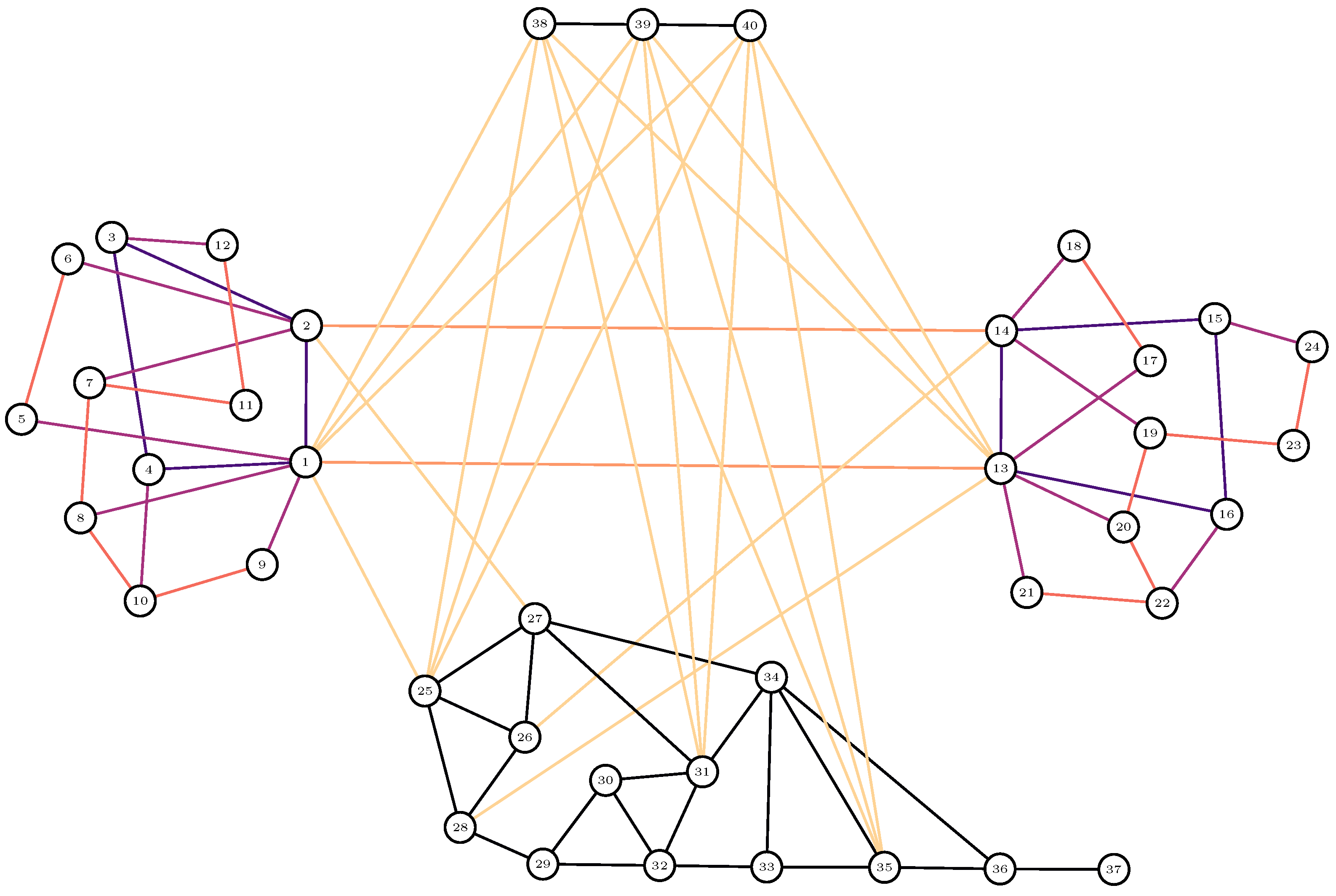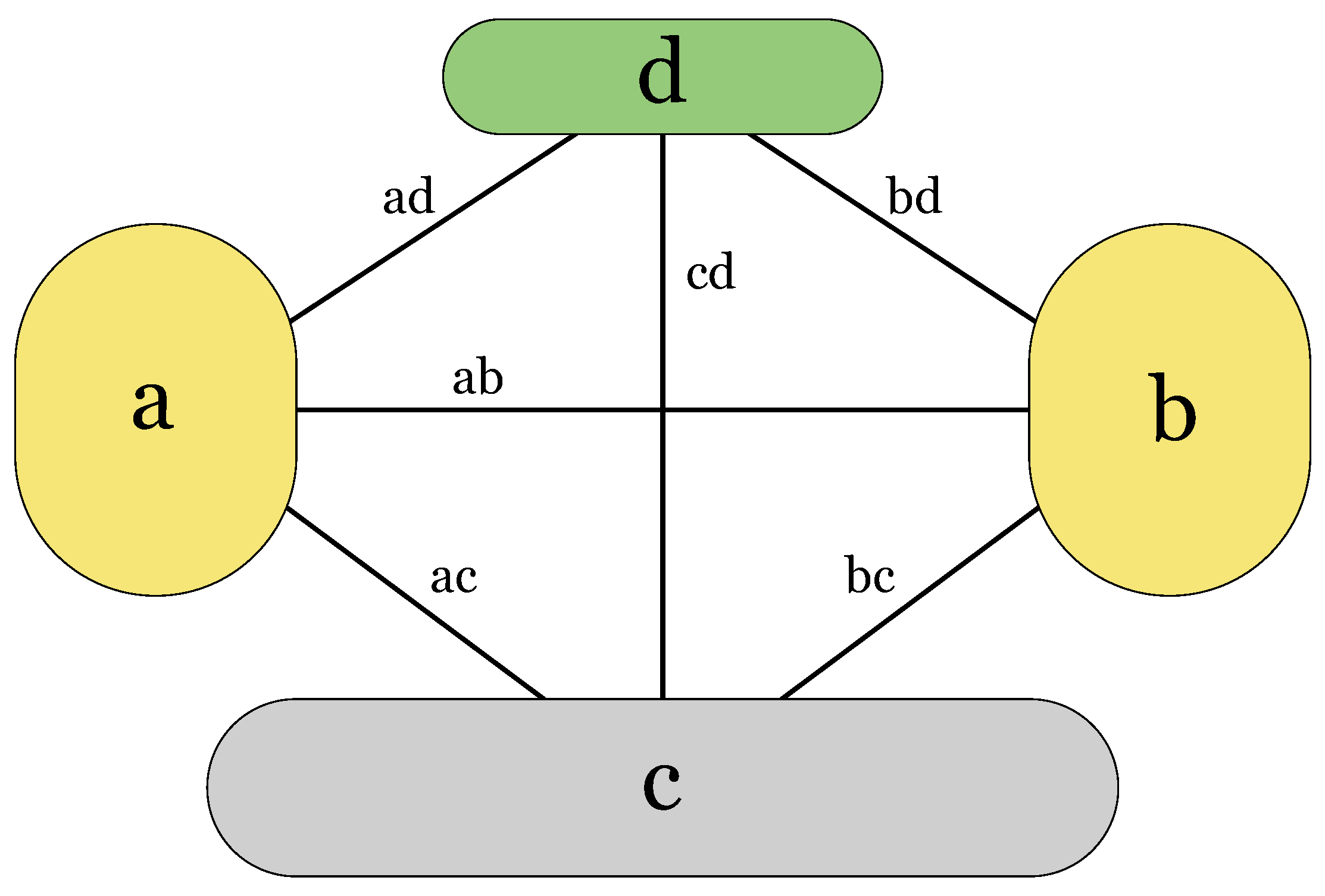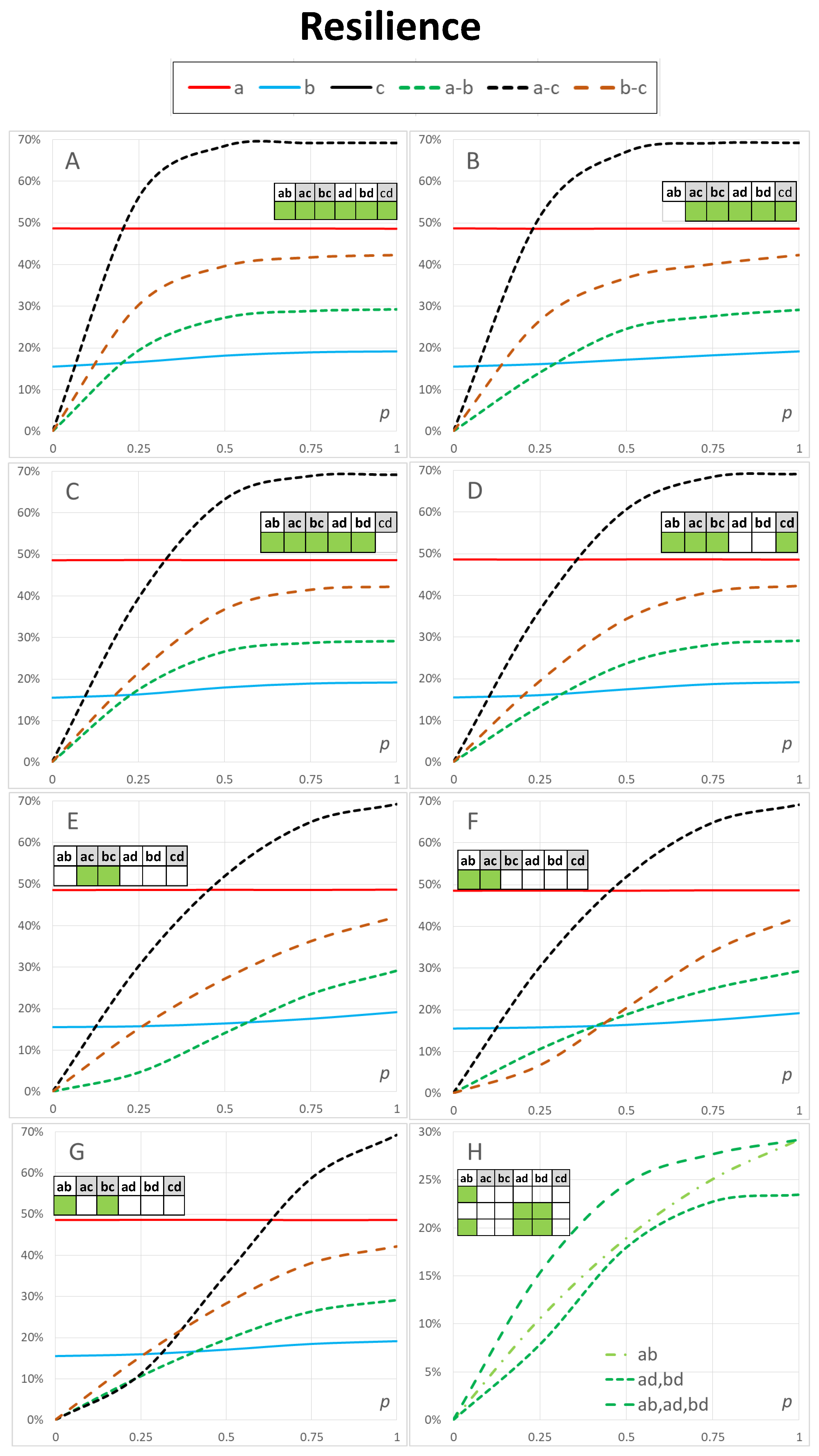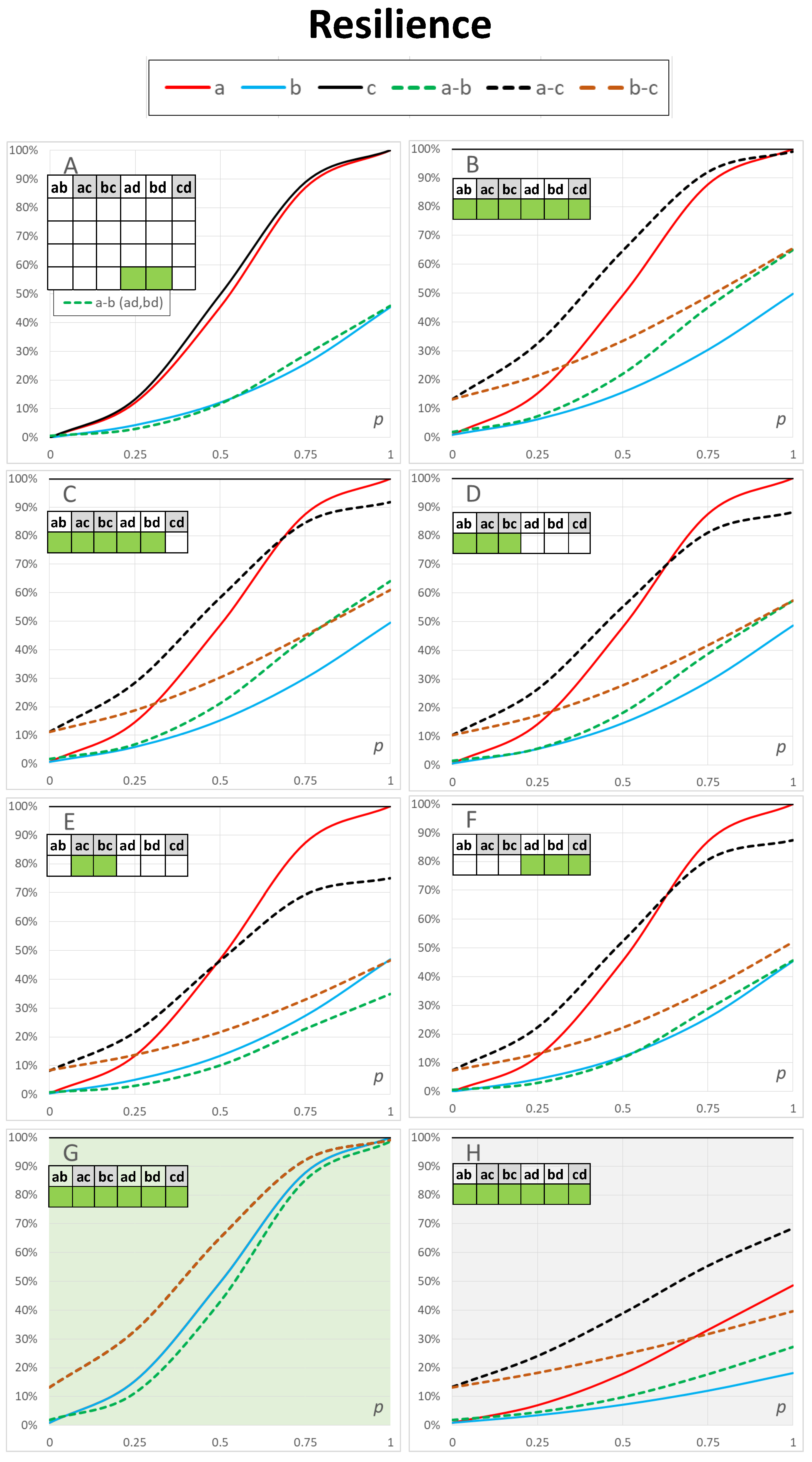Resilience of Multi-Layer Communication Networks
Abstract
1. Introduction
1.1. Drivers for Resilient Communication
1.2. Elements of Multilayer Heterogeneous Network
1.3. 3GPP 5G Nonterrestrial Network (NTN) Standardisation Activities
1.4. Network Resilience in 5G Networks and Beyond
1.5. Modelling the Resilience of Networks
2. Methods of Modelling the Resilience of Heterogeneous Systems of Networks
2.1. Extending the Traditional Methods of Modelling Network Reliability
2.2. Modelling Network Structures
2.3. Theory of Network Connectivity and Resilience
2.4. Definitions of Centrality and Betweenness measures
3. Case Study Results
| Symbol | Network | Section 3.1 | Section 3.2 |
|---|---|---|---|
| a | Access Network a | 0.0–1.0 | |
| b | Access Network b | 0.0–1.0 | |
| c | Backbone network | ||
| d | Satellite network | ||
| ab | Connections between a and b | 0.0–1.0 | |
| ac | Connections between a and c | 0.0–1.0 | |
| bc | Connections between b and c | 0.0–1.0 | |
| ad | Connections between a and d | 0.0–1.0 | |
| bd | Connections between b and d | 0.0–1.0 | |
| cd | Connections between c and d | 0.0–1.0 |
3.1. Effects of Connectivity between Networks
3.2. Effects of Connectivity within Networks
3.3. Betweenness and Centrality Results
4. Discussion and Contributions
- 1
- We extended the traditional theory of modelling the reliability and functioning of network connections [3] by defining the concept of sufficient resilience. This can be defined more freely in specific scenarios to cover different technical and functional quality requirements.
- 2
- We proposed a detail-level network model describing link resilience. Resilience within or between any collection of nodes in the network structure can be computed on the basis of a definition of a resilient communication link. Links were assumed to be statistically independent, which enabled the use of mathematical formulas of traditional network theory.
- 3
- The model considers connections within a network structure, for example, a subnetwork or a connected network in a system of networks, and connections between network structures when resilience values within or between the network structures are computed. This method provides useful results because, in practice, the concept of resilience should take into account the entire system, affecting the probability of conducting successful computer-aided operations.
- 4
- We proposed an alternative model [25], the network spreading model, based on modelling spreading processes via self-avoiding paths in the network structure. This model and the classical network connectivity model provide similar results. Extensions of the spreading model can be used to model various spreading processes in the network and thus enable more applications of the methodology. In addition, new ideas in the context of the spreading model can be used for studying the resilience of networked systems. On the other hand, classical network reliability theory can have new interpretations in many other application areas of spreading models in social, biological and technological network analyses [19,20,25].
- 5
- We have shown by example how analysing centrality and betweenness measure results together with network resilience calculations can be used to locate important nodes and links in the network structure whose enhanced resilience, for example by building a parallel connection, would probably improve and maximise the overall network resilience.
5. Conclusions
Author Contributions
Funding
Acknowledgments
Conflicts of Interest
Abbreviations
| 3GPP | 3rd Generation Partnership Project |
| 5G | Fifth Generation |
| 5G NTN | 5G Non terrestrial networks |
| EU | European Union |
| GEO | Geostationary Orbit |
| IoT | Internet of Things |
| IP | Internet Protocol |
| JADC2 | Joint All-Domain Command and Control |
| LEO | Low Earth Orbit |
| MANET | Mobile Adhoc Networking |
| NFV | Network Function Virtualisation |
| NTN | Non-Terrestrial Network |
| OSI | Open Systems Interconnection |
| QoS | Quality of Service |
| SATCOM | Satellite Communication |
| SBA | Service-based Architecture |
| SDN | Software-Defined Networking |
| SLA | Service-Level Agreement |
| UE | User Equipment |
References
- Andrews, J.; Shakkottai, S.; Heath, R.; Jindal, N.; Haenggi, M.; Berry, R.; Guo, D.; Neely, M.; Weber, S.; Jafar, S.; et al. Rethinking information theory for mobile ad hoc networks. IEEE Commun. Mag. 2008, 46, 94–101. [Google Scholar] [CrossRef]
- Lin, X.; Rommer, S.; Euler, S.; Yavuz, E.A.; Karlsson, R.S. 5G from Space: An Overview of 3GPP Non-Terrestrial Networks. IEEE Commun. Mag. 2021, 5, 147–153. [Google Scholar] [CrossRef]
- Congressional Research Services. 2021. Joint All-Domain Command and Control (JADC2). Available online: https://crsreports.congress.gov/product/pdf/IF/IF11493 (accessed on 1 September 2022).
- TELE.NET. Better Together: The role of SDN and NFV in the 5G era. tele.net. 2022. Available online: https://tele.net.in/better-together-the-role-of-sdn-and-nfv-in-the-5g-era/ (accessed on 1 September 2022).
- da Silva, A.S.; Smith, P.; Mauthe, A.; Schaeffer-Filho, A. Resilience support in software-defined networking: A survey. Comput. Netw. 2015, 92, 189–207. [Google Scholar] [CrossRef]
- Kuikka, V.; Syrjänen, M. Modelling Utility of Networked Services in Military Environments. In Proceedings of the 2019 International Conference on Military Communications and Information Systems (ICMCIS), Budva, Montenegro, 14–15 May 2019; pp. 104773–104819. [Google Scholar] [CrossRef]
- Çetinkaya, E.K.; Sterbenz, J.P. A taxonomy of network challenges. In Proceedings of the 2013 9th International Conference on the Design of Reliable Communication Networks (DRCN), Budapest, Hungary, 4–7 March 2013; pp. 322–330. [Google Scholar]
- Hutchison, D.; Sterbenz, J.P. Architecture and design for resilient networked systems. Comput. Commun. 2018, 131, 13–21. [Google Scholar] [CrossRef]
- Smith, P.; Hutchison, D.; Sterbenz, J.P.; Schöller, M.; Fessi, A.; Karaliopoulos, M.; Lac, C.; Plattner, B. Network resilience: A systematic approach. IEEE Commun. Mag. 2011, 49, 88–97. [Google Scholar] [CrossRef]
- Sterbenz, J.P. Smart city and IoT resilience, survivability, and disruption tolerance: Challenges, modelling, and a survey of research opportunities. In Proceedings of the 2017 9th International Workshop on Resilient Networks Design and Modeling (RNDM), Alghero, Italy, 4–6 September 2017; pp. 1–6. [Google Scholar] [CrossRef]
- Information and Telecommunication Center. Definitions. Resinets Wiki. 2014. Available online: https://en.wikipedia.org/wiki/Information_and_communications_technology (accessed on 1 September 2022).
- National Institute of Standards and Technology. Network Resilience, Glossary. 2015. Available online: https://csrc.nist.gov/glossary/term/network-resilience (accessed on 1 September 2022).
- Sterbenz, J.P.G.; Hutchison, D.; Çetinkaya, E.K.; Jabbar, A.; Rohrer, J.P.; Schöller, M.; Smith, P. Redundancy, diversity, and connectivity to achieve multilevel network resilience, survivability, and disruption tolerance invited paper. Telecommun. Syst. 2014, 56, 17–31. [Google Scholar] [CrossRef]
- ITU-T Study Group 2. Introduction to Grade-of-Service = GoS. In Teletraffic Engineering Handbook, Chapter 1.11; The Telecommunication Development Bureau: Geneva, Switzerland, 2009. [Google Scholar]
- Alenazi, M.J.; Sterbenz, J.P. Comprehensive comparison and accuracy of graph metrics in predicting network resilience. In Proceedings of the 2015 11th International Conference on the Design of Reliable Communication Networks (DRCN), Kansas City, MO, USA, 24–27 March 2015; pp. 157–164. [Google Scholar] [CrossRef]
- Alenazi, M.J.F.; Sterbenz, J.P. Evaluation and comparison of several graph robustness metrics to improve network resilience. In Proceedings of the 2015 7th International Workshop on Reliable Networks Design and Modeling (RNDM), Munich, Germany, 5–7 October 2015; pp. 7–13. [Google Scholar] [CrossRef]
- Page, L.; Perry, J. Reliability polynomials and link importance in networks. IEEE Trans. Reliab. 1994, 43, 51–58. [Google Scholar] [CrossRef]
- Ball, M.O.; Colbourn, C.J.; Provan, J.S. Chapter 11 Network reliability. In Handbooks in Operations Research and Management Science; Elsevier: Amsterdam, The Netherlands, 1995; Volume 7, pp. 673–762. [Google Scholar]
- Kuikka, V. Number of system units optimizing the capability requirements through multiple system capabilities. J. Appl. Oper. Res. 2016, 8, 26–41. [Google Scholar]
- Kuikka, V.; Aalto, H.; Kaski, K.K. Efficiency of Algorithms for Computing Influence and Information Spreading on Social Networks. Algorithms 2022, 15, 262. [Google Scholar] [CrossRef]
- Sterbenz, J.P.; Kulkarni, P. Diverse infrastructure and architecture for datacenter and cloud resilience. In Proceedings of the 2013 22nd International Conference on Computer Communication and Networks (ICCCN), Nassau, Bahamas, 30 July–2 August 2013; pp. 1–7. [Google Scholar] [CrossRef]
- Ashraf, U.; Yuen, C. Capacity-Aware Topology Resilience in Software-Defined Networks. IEEE Syst. J. 2018, 12, 3737–3746. [Google Scholar] [CrossRef]
- Kuikka, V. Modeling Network Resilience and Utility of Services. In Proceedings of the 2019 IEEE International Systems Conference (SysCon), Orlando, FL, USA, 8–11 April 2019; pp. 1–5. [Google Scholar] [CrossRef]
- Wan, Z.; Mahajan, Y.; Kang, B.W.; Moore, T.J.; Cho, J.H. A Survey on Centrality Metrics and Their Network Resilience Analysis. IEEE Access 2021, 9, 104773–104819. [Google Scholar] [CrossRef]
- Kuikka, V. Modelling community structure and temporal spreading on complex networks. Comput. Soc. Netw. 2020, 8, 1–38. [Google Scholar] [CrossRef]








| Figure | ab | ac | bc | ad | bd | cd |
|---|---|---|---|---|---|---|
| Figure 3A | y | y | y | y | y | y |
| Figure 3B | y | y | y | y | y | |
| Figure 3C | y | y | y | y | y | |
| Figure 3D | y | y | y | y | ||
| Figure 3E | y | y | ||||
| Figure 3F | y | y | ||||
| Figure 3G | y | y | ||||
| Figure 3H | y | |||||
| Figure 3H | y | y | ||||
| Figure 3H | y | y | y |
Disclaimer/Publisher’s Note: The statements, opinions and data contained in all publications are solely those of the individual author(s) and contributor(s) and not of MDPI and/or the editor(s). MDPI and/or the editor(s) disclaim responsibility for any injury to people or property resulting from any ideas, methods, instructions or products referred to in the content. |
© 2022 by the authors. Licensee MDPI, Basel, Switzerland. This article is an open access article distributed under the terms and conditions of the Creative Commons Attribution (CC BY) license (https://creativecommons.org/licenses/by/4.0/).
Share and Cite
Kuikka, V.; Rantanen, H. Resilience of Multi-Layer Communication Networks. Sensors 2023, 23, 86. https://doi.org/10.3390/s23010086
Kuikka V, Rantanen H. Resilience of Multi-Layer Communication Networks. Sensors. 2023; 23(1):86. https://doi.org/10.3390/s23010086
Chicago/Turabian StyleKuikka, Vesa, and Heikki Rantanen. 2023. "Resilience of Multi-Layer Communication Networks" Sensors 23, no. 1: 86. https://doi.org/10.3390/s23010086
APA StyleKuikka, V., & Rantanen, H. (2023). Resilience of Multi-Layer Communication Networks. Sensors, 23(1), 86. https://doi.org/10.3390/s23010086






